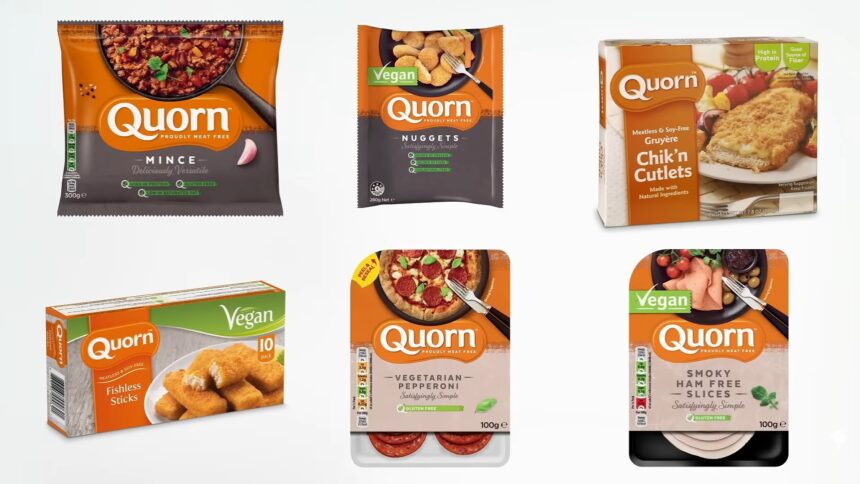Clinical trials on Quorn show that it can improve satiety and help control cholesterol, blood sugar, and insulin levels.
You may have heard about meats made from wheat protein (like Field Roast sausages and Upton’s bacon seitan), meats made from soybean protein (like the Impossible Whopper and Gardein’s wings), and meats made from pea protein (like Beyond Sausage and Good Catch’s fish-free tuna), but what about meats made from mycoprotein? A relatively new addition, meats made from the mushroom kingdom are popular in Europe and have been introduced into the U.S. marketplace, commercialized as Quorn, which makes cow-free beef, chicken-free chicken, fish-free fish, and pig-free pork, as seen here and at 0:35 in my video The Health Effects of Mycoprotein (Quorn) Products vs. BCAAs in Meat.

In terms of environmental impact, Quorn beef has a carbon footprint that’s at least ten times smaller than conventional beef, and Quorn chicken is at least four times lower than conventional chicken. Health-wise, “mycoprotein is high in protein and fiber, and low in fat, cholesterol, sodium, and sugar,” as one would expect. Most importantly, there have been clinical trials showing it may help control cholesterol, blood sugar, and insulin levels, as well as improve satiety. No surprise given that the fiber and the mycoprotein itself are fermentable by our good gut bugs, so it can also act as a prebiotic for our friendly flora.
There have been rare, authenticated reports of people with mycoprotein allergies and even more with unvalidated complaints, but, given how many billions of packages have been sold, the rate of allergic reactions may be on the order of around 1 in 9 million.
The cholesterol data, as seen below and at 1:40 in my video, have been converted into U.S. numbers. There were significant drops in total and LDL cholesterol—more than 30 points within eight weeks.

In terms of satiety, as I noted in my Evidence-Based Weight Loss presentation, both tofu and Quorn have been found to have stronger satiating qualities than chicken. Consumption of Quorn, for instance, cut down on subsequent meal intake hours later for lean subjects, as well as reduced it for overweight and obese individuals.
You know, it’s funny when the meat industry funds obesity studies on chicken. For its head-to-head comparison foods, it chooses items like “shortbread cookies and sugar-coated chocolates.” This is a classic drug industry trick where you make your product look better by comparing it against something worse. (Apparently, regular chocolate wasn’t bad enough to make chicken look better, so had to be chocolate coated in sugar.) But what happens when a chicken is pitted against a real control, like a chicken without the actual chicken? Chicken chickens out, as it was “clearly demonstrated that a Quorn-based meal has greater satiating efficiency than a chicken-based meal.” For example, when study participants ate a chicken and rice lunch, they ate 18 percent more of a dinner buffet four and a half hours later than those who had instead eaten a lunch of Quorn and rice and cut about 200 calories on average.
As seen here and a 3:01 in my video, part of the reason plant-based meats may be less fattening is that they cause less of an insulin spike. A meat-free chicken like Quorn causes up to 41 percent less of an immediate insulin reaction.

It turns out that animal protein causes almost exactly as much insulin release as pure sugar, as you can see below and at 3:03 in my video.

Just adding some egg whites to your diet can increase insulin output by 60 percent within four days, as seen here and at 3:16.

And fish may be even worse, as shown below, and at 3:21.

Why would adding tuna to mashed potatoes spike up insulin levels, but adding broccoli instead drop the insulin response by about 40 percent? It’s not the fiber, since giving the same amount of broccoli fiber alone provided no significant benefit. So, why does animal protein make things worse, but plant protein makes things better?
Plant proteins tend to have lower levels of the branched-chain amino acids, which are associated with insulin resistance—the cause of type 2 diabetes. You can show this experimentally. Give some vegans branched-chain amino acids, and you can make them as insulin-resistant as omnivores. Or, take omnivores and put them through a 48-hour vegan diet challenge, and within two days, you can see the opposite—significant improvements in metabolic signatures. Why? As the study is titled, “Decreased Consumption of Branched-Chain Amino Acids Improves Metabolic Health.” Those randomized to restrict their protein intake were averaging intake of literally hundreds more calories per day, so they should have gotten heavier, right? But, no. They actually lost more body fat. Restricting their protein enabled them to eat more calories, while at the same time, they lost more weight. More calories, yet a loss of body fat. And this magic “protein restriction”? The study participants were just eating the recommended amount of protein. So, maybe the researchers should have called the “protein-restricted” group the “normal protein” group or the “recommended protein” group, and the control group eating more typical American protein levels—and suffering because of it—the “excess protein” group.
Given the “restoration of metabolic health by decreased consumption of branched-chain amino acids,” leaders in the field have suggested the invention of drugs to block their absorption to “promote metabolic health and treat diabetes and obesity without reducing caloric intake.” Or we can just try not to eat so many branched-chain amino acids in the first place.
They are found mostly in meat, including chicken and fish, dairy products, and eggs, which may help explain why animal protein has been associated with higher diabetes risk, whereas plant protein appears protective. So, “defining appropriate upper limits” of animal protein intake “may offer a great chance for the prevention of T2D [type 2 diabetes] and obesity.”
This is part of a nine-part series on plant-based meats. If you’ve missed any of the previous installments, check out the related posts below.
Up next:
- What About the Heme in Impossible Burgers?
- Does Heme Iron Cause Cancer?
- Heme-Induced N-Nitroso Compounds and Fat Oxidation
- Is Heme the Reason Meat Is Carcinogenic?
I mentioned my Evidence-Based Weight Loss presentation, which you can watch here.






